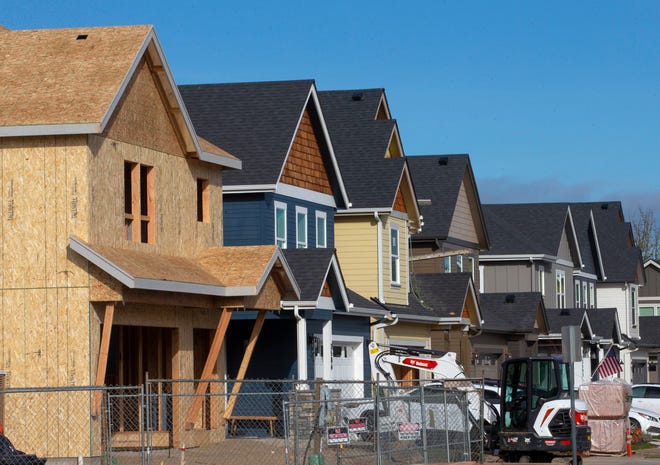Lawmakers Unveil $400 Million Housing Plan
Written
 Majority Democrats in the Oregon Legislature have unveiled their plan to spend $400 million to ease homelessness and promote lower-cost housing, on top of a record $700 million that lawmakers approved last year.
Majority Democrats in the Oregon Legislature have unveiled their plan to spend $400 million to ease homelessness and promote lower-cost housing, on top of a record $700 million that lawmakers approved last year.
The amount is in line with what Gov. Kate Brown proposed at the start of the session. It is split between $165 million for shelter operations, referrals and other emergency housing programs; $215 million for repairs and construction of lower-cost housing, manufactured-home parks and land acquisition, and $20 million for help for first-time home buyers.
The legislative session is scheduled to end by March 7.
Lawmakers told reporters on Thursday, Feb. 24, they are under no illusions the plan will drastically reduce the number of homeless people or dramatically increase the supply of lower-cost housing — affordable by low-income families — in the short term.
But they also said those issues are statewide, not limited to the Portland metro area.
Rep. Jason Kropf of Bend said he has been carefully reading a series in The Bulletin newspaper recounting the stories of people who do not have housing.
“The series underscores that those who are unhoused and unsheltered are as diverse as our community itself,” Kropf said.
“It saddens me to know there are people in my community going through this. But I know it is a top priority for me and this community to tackle this crisis.”
Record state tax collections, plus federal support from the American Rescue Plan Act, have boosted the amount of money that lawmakers have on hand to spend.
Most of the money will come through an end-of-session budget bill — and most will go to existing programs run by local governments and community groups.
House Majority Leader Julie Fahey of Eugene, who leads the House panel, said lawmakers have to fund both emergency and long-term programs.
“Our north star has to be making investments in housing programs that actually work to get people on the path out of homelessness, not just move them from one place to another or warehouse them somewhere out of sight,” she said. “These are local safety-net services that catch people before they become homeless and that reach out to help get people off the street and into shelter or housing.
“I want to make clear these investments will not solve every problem overnight. But Oregonians have immediate needs right now.”
Stable Homes for Oregon Families, a coalition that has advocated help for low-income renters and homeowners, urged lawmakers to approve the plan.
“We urge swift passage of this immediate state response,” the coalition said in a statement. “All children deserve a roof over their head and a safe place to live. Like air to breathe and food to eat, safe shelter is a basic human need and this package will help Oregon ensure that safe shelter for more people in our community.”
Immediate needs
Among proposed homelessness spending is $25 million for Oregon’s largest cities and counties — among them the three Portland metro counties, plus Hillsboro, Beaverton and Bend — and $50 million more for Project Turnkey. Under that program, which is run by the Oregon Community Foundation, 19 former motels have been converted into 867 units with total spending of about $75 million in the past 18 months or so. Some were created in areas hit hard, such as Southern Oregon, by the 2020 Labor Day wildfires.
Of the 19 projects, two in Deschutes County are for a total of 53 units.
“We can go back and say that program was a success,” Fahey said. “We have prioritized investing these funds into proven programs that have shown results in getting people on that path out of homelessness.”
Another $8 million will go to task forces, one for each of eight regions largely outside the Portland metro area, that will bring together local governments and community agencies to help people without permanent shelter. It is loosely based on the Joint Office of Homeless Services run by Multnomah County and the city of Portland.
Kropf is the chief sponsor of House Bill 4123, which would set up the framework for the task forces, one of which will be in Central Oregon.
Bend City Councilor Anthony Broadman, who also took part in the presentation, praised the Legislature’s emphasis on local coalition-building.
The bulk of the money ($80 million) is for shelter operations, referrals, housing stability and other emergency measures.
Increasing supply
Fahey said during a recent interview that lawmakers will have more work to do in the 2023 session to help figure out ways to boost the supply of housing, which Josh Lehner, a state economist, has estimated is 111,000 units short of what Oregon needs and has not kept pace with population growth. Of that total, Lehner told lawmakers on Feb. 9, about half (54,000) is needed by families who earn half or less of the area’s median income, roughly $40,000.
But Fahey said much of the $215 million proposed in the plan will go toward such housing. Among the items: $65 million to repair and preserve existing lower-cost housing so that it stays on the market; $55 million for new construction, both rentals and owner-occupied housing; $35 million for manufactured home parks; $10 million for land acquisition, and $50 million to complete unfinished projects facing difficulties.
“Oregon needs to build more housing,” Rep. Mark Meek of Oregon City said. “As a Realtor, I know too many families struggle to make ends meet with rising rents and home prices. It’s time to stop making excuses. Oregon needs to build pathways toward home ownership. Expanding home ownership means helping people of all backgrounds generate inter-generational wealth.”
Based on a housing analysis yet to come from two state agencies, Fahey said, lawmakers in 2023 will confront how Oregon can increase its amount of housing.
The final $20 million in the plan is intended to boost agencies that help first-time home buyers.







